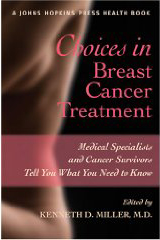Choices in Breast Cancer Treatment
| |||||||||||||||||||||||
Call me "Coach." Breast Cancer Coach, to be exact. It’s a volunteer role I play on a regular basis. The phone might ring on a quiet Sunday evening after dinner. Or an unexpected email will pop up on my computer screen. The woman reaching out to me might be a-friend-of-a-friend-of-a-friend. Or the niece of a co-worker. (When it comes to Breast CancerLand, the female underground is a true thing of beauty, isn’t it?)
Typically the women I connect with are newly diagnosed and eager to hear part of my personal story - how did I make my treatment decisions way back when? Ultimately the ladies bring the discussion around to the same burning question every time: what should I do? they ask me. I listen and feel their intense frustration.
"I’ve gotten four opinions," said one woman to me recently. "Mastectomy or lumpectomy with radiation. One doctor said I absolutely needed eight rounds of chemotherapy. Another one said I didn’t need radiation at all. What am I supposed to do? Go to medical school so that I can figure it all out?"
There’s a far less painful option, ladies: please read Dr. Miller’s book.
According to Dr. Miller, a practicing medical oncologist, "…unlike many other medical conditions that have a single best plan of action presented by the doctor, breast cancer is a disease that requires each patient to make many decisions about her treatment plan. Initially, most women feel totally unequipped to face this challenge. Most are very scared, and the complexities of the treatment choices can seem overwhelming at first."
Choices in Breast Cancer Treatment is actually two books in one: a Breast Cancer 101 Course textbook (that teaches patients all they need to know about the disease, surgery, chemotherapy, radiation and breast reconstruction), as well as a collection of breast cancer survivor memoirs (survivors representing stages 0-4 share their CancerLand journeys in their own words). An added bonus is a section of survivor accounts written by three women who are also health care professionals. In my opinion, a breast cancer book like this one that neatly balances clinical information with patient anecdotes fills a real gap in the literature.
Clearly, this is a reference volume that invites the reader to browse based on need. Dr. Miller organizes the book with the factual elements in the first half. He makes these chapters more accessible to the layperson by featuring a photograph of each chapter author and by including illustrations to depict difficult concepts. Many such concepts are repeated from chapter to chapter to effectively clarify them for the reader. In the latter part of the book, the memoir section groups survivor stories by stage so that a woman diagnosed with stage 2 breast cancer, for example, can find her own situation reflected on the page.
One survivor shares these words of wisdom:
"The first life lesson that this has taught me was that you have to take charge of your own body. You can go to as many people as you want for opinions, but the ultimate decision has to be your own. To make a decision like this you have to feel confident that you have exhausted all intellectual avenues to discover what your options are."
In an era where the hope is that breast cancer patients work as partners with their medical team, Dr. Miller’s Choices in Breast Cancer Treatment is a wonderful tool to meet that goal.


